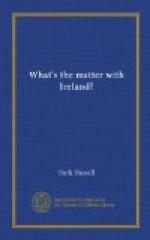In the evening I heard the murmur of revolution. With the shawled mothers who line the lane on a pleasant evening, I stood between the widow and a twenty-year-old girl who held her tiny blind baby in her arms. Across the narrow street with its water-filled gutters, barefoot children in holey sweaters or with burlap tied about their shoulders, slapped their feet as they jigged, or jumped at hop-scotch. Back of them in typical Dublin decay rose the stables of an anciently prosperous shipping concern; in the v dip of the roofless walls, spiky grass grew and through the barred windows the wet gray sky was slotted. Suddenly the girl-mother spoke:
“Why, there’s himself coming back, Mary. See him turning up from the timber on the quay. There was sorrow in his eyes like the submarine times when he came to tell me no boat docked this morning. Baby or no baby, I’ll have to get work for myself, for he’s not given me a farthing for a fortnight.”
A big Danish-looking chap was homing towards the door. Without meeting the girl’s eyes, he slunk into the doorway. His broad shoulders sagged under his sun-faded coat, and he blocked the light from the glassless window on the staircase as he disappeared. When he slouched out again his hand dropped from his hip pocket.
“It’s to drill he’s going,” The young mother snugged her shawl in more tightly about her baby. Then she said with a little break in her voice: “Oh, it’s very pleasant, just this, with the girls jigging and rattling their legs of a spring evening.”
A girl’s voice defiantly telling a soldier that if he didn’t wear his civvies when he came to call he needn’t come at all, rose clearly from a dark doorway. A lamplighter streaked yellow flame into the square lamp hanging from the stone shell opposite. A jarvey, hugging a bundle of hay, drove his horse clankingly over the cobblestones. Then grimly came the whisper of the widow of the rebellion close to my ear:
“Oh, we’ll have enough in the army this time.”
Difficult as the Irish worker’s fight is, the able person is loath to give up and accept charity. But whether she wants to or not, if she can’t find work she must go to the poorhouse. Before the war it was estimated that over one-half the inmates of the Irish workhouses were employable. During the war, when there were more jobs than usual to be had, there was a great exodus from the hated poorhouse; there was a drop in workhouse wards from 400,000 to 250,000. But now jobs are getting less again and there is a melancholy return back over the hills to the poorhouse.
Night refuges, I found, are the last stage in this journey. There, with every day out of work, women become more unemployable—clothes and constitutions wear out; minds lose hope in effort and rely on luck. As I sat with a tableful of charwomen and general housework girls in a refuge in Dublin, I read two ads from the paper. One offered a job for a general servant with wages at $50 a year. The other ran: “Wanted: a strong humble general housework girl to live out; $1.25 a week.” I put the choice up to the table.




